A Study on the Current Status and Reduction Method Caused by Lightning at Educational Facilities
Abstract
:1. Introduction
2. Lightning Protection System
2.1. External LPSs
2.2. Internal LPSs
3. Results and Discussion
3.1. Analysis of the Current Status of LPSs
3.2. Lightning Damage Reduction Measures for Education Facilities
4. Conclusions
Author Contributions
Funding
Institutional Review Board Statement
Informed Consent Statement
Data Availability Statement
Conflicts of Interest
References
- Korea Meteorological Administration. Lightning Yearbook; Korea Meteorological Administration: Seoul, Korea, 2019.
- National Fire Agency. National Fire Data System; National Fire Agency: Sejong, Korea, 2020.
- International Electrotechnical Commission. Protection Against Lightning-Part 1: General Principles; IEC 62305-1; International Electrotechnical Commission: Geneva, Switzerland, 2004. [Google Scholar]
- Martin, U. The Lightning Discharge; Courier Corporation: North Chelmsford, MA, USA, 2001. [Google Scholar]
- Jingxiao, L. An experimental study of the damage degrees to ancient building timber caused by lightning strikes. J. Electrost. 2017, 90, 23–30. [Google Scholar]
- Jingxiao, L. Investigation of lightning damage mechanism and flashover channels on glazed roofing tiles of ancient buildings through laboratory experiments. J. Electrost. 2021, 110, 103553. [Google Scholar]
- Jinru, S. Experimental and numerical analysis of damage characteristics to opgw strands under first lightning strike and continuous currnet. Electr. Power Syst. Res. 2020, 187, 106515. [Google Scholar]
- Rafael, A. Ground potential rise in wind farms due to direct lightning. Electr. Power Syst. Res. 2021, 194, 107110. [Google Scholar]
- Zmnako, M. Lightning-induced transient effects in a hybrid PV-wind system and mitigation strategies. Electr. Power Syst. Res. 2019, 174, 105882. [Google Scholar]
- Korea Institute of Educational Facility Safety. Damage Compensation; Korea Institute of Educational Facility Safety: Seoul, Korea, 2019. [Google Scholar]
- Regulation for Facility in Buildings in Korea, Article 20. 2020. Available online: https://www.law.go.kr/LSW/lsInfoP.do?efYd=20201010&lsiSeq=217537#0000 (accessed on 21 May 2021).
- Korea Electrotechnical Code 150, Lightning Protection System. 2021. Available online: https://law.go.kr/flDownload.do?flSeq=95633687 (accessed on 21 May 2021).
- International Electrotechnical Commission. Protection Against Lightning-Part 2: Risk Management; IEC 62305-2; International Electrotechnical Commission: Geneva, Switzerland, 2010. [Google Scholar]
- International Electrotechnical Commission. Protection Against Lightning-Part 3: Physical Damage to Structures and Hazard; IEC 62305-3; International Electrotechnical Commission: Geneva, Switzerland, 2010. [Google Scholar]
- International Electrotechnical Commission. Protection Against Lightning—Part 4: Electrical and Electronic System within Structures; IEC 62305-4; International Electrotechnical Commission: Geneva, Switzerland, 2003. [Google Scholar]
- Horvath, T. Standardization of lightning protection based on the physics or on the tradition. J. Electrost. 2004, 60, 265–275. [Google Scholar] [CrossRef]
- nVent-ERICO. nVent ERICO Lightning Protection Handbook; nVent: Solon, OH, USA, 2018; Available online: https://www.erico.com/catalog/literature/E907W-WWEN.pdf (accessed on 21 May 2021).
- Zoltan, T. Relation between the material of roof and the risk of lightning caused damage: The rolling sphere method in the use. Electr. Power Syst. Res. 2021, 196, 107286. [Google Scholar]
- Szedenik, N. Rolling sphere—Method or theory? J. Electrost. 2001, 51–52, 345–350. [Google Scholar] [CrossRef]
- International Electrotechnical Commission. Low-Voltage Surge Protective Devices–Part 12: Surge Protective Devices Connected to Low-Voltage Power Systems—Selection and Application Principles; IEC 61643-12; International Electrotechnical Commission: Geneva, Switzerland, 2002. [Google Scholar]
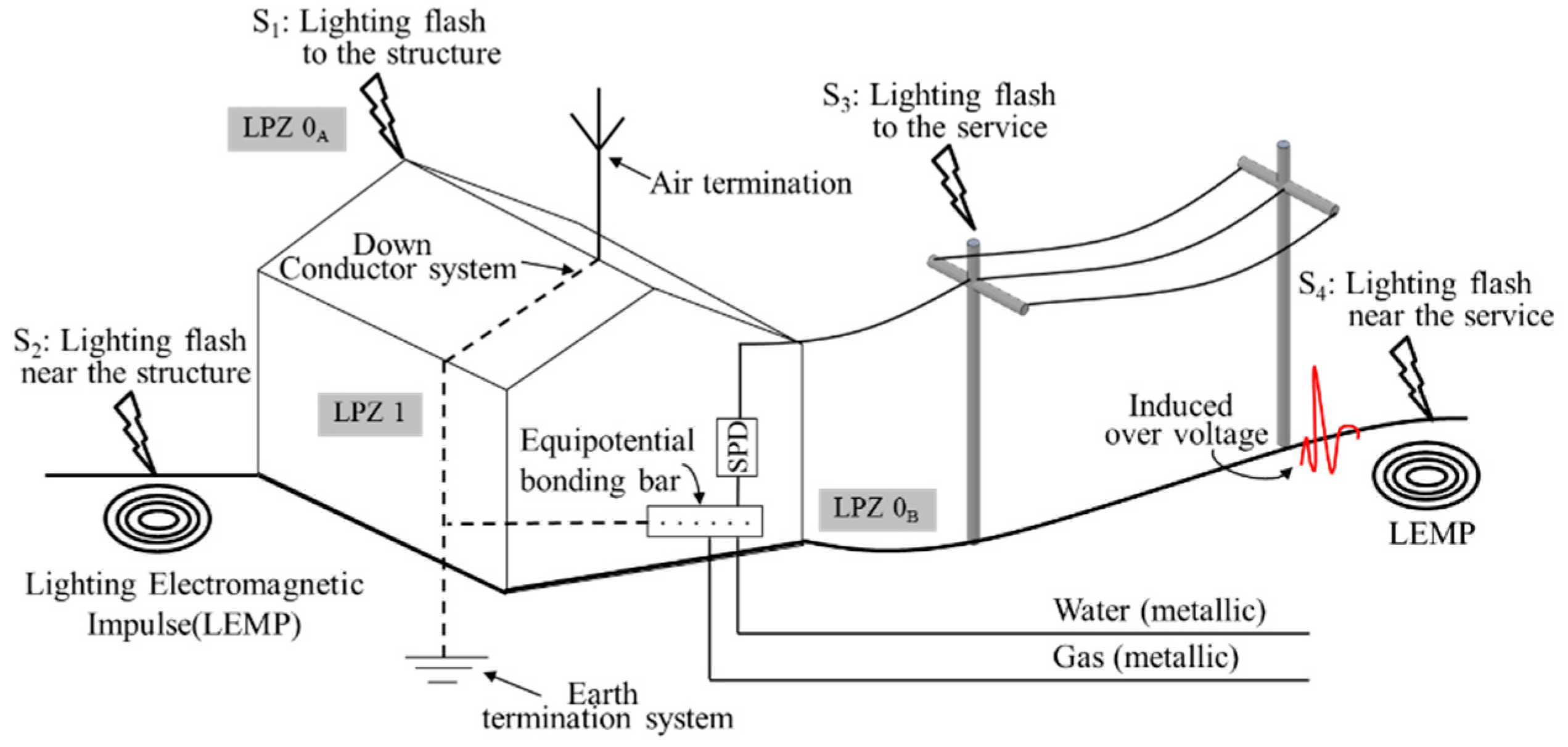
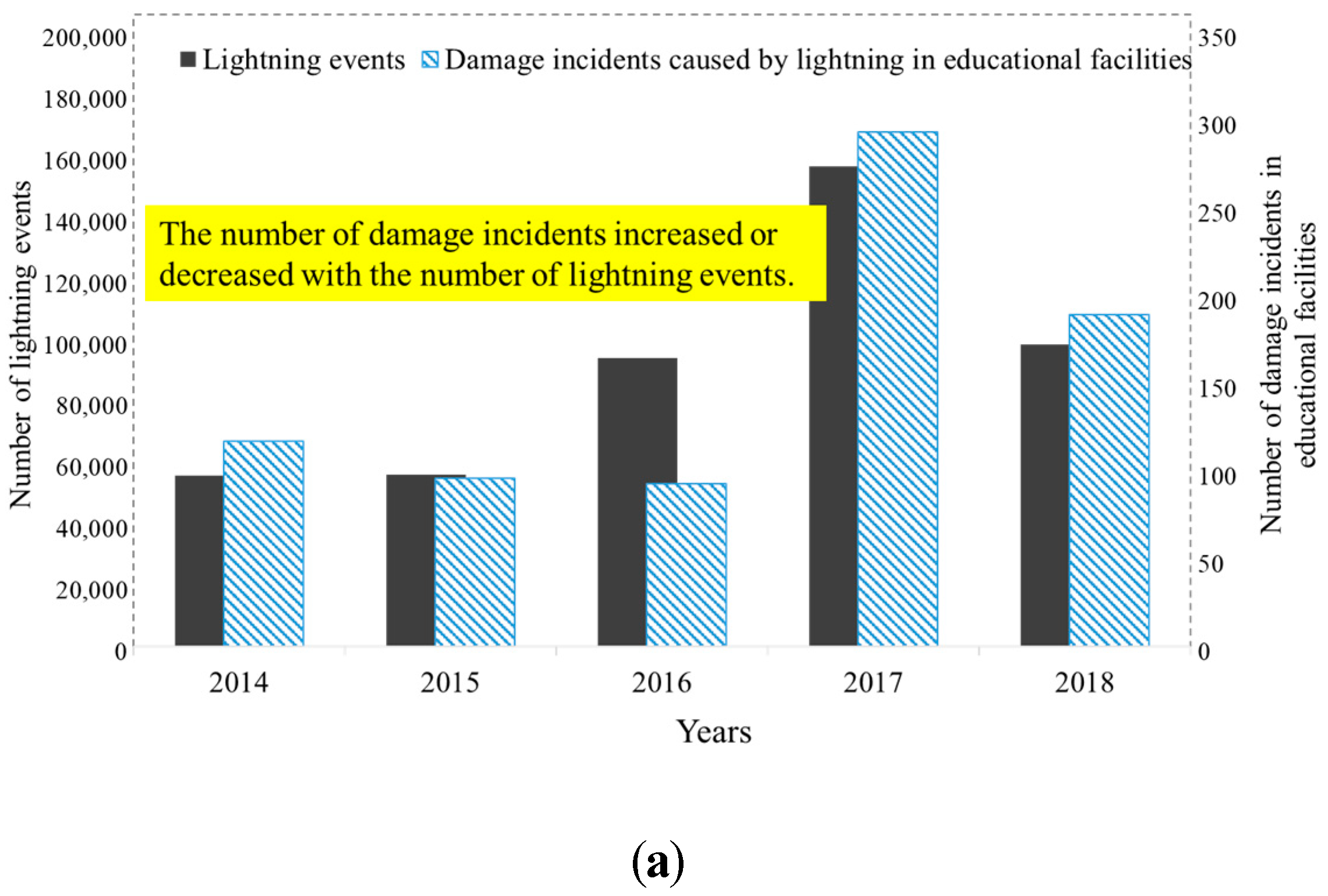
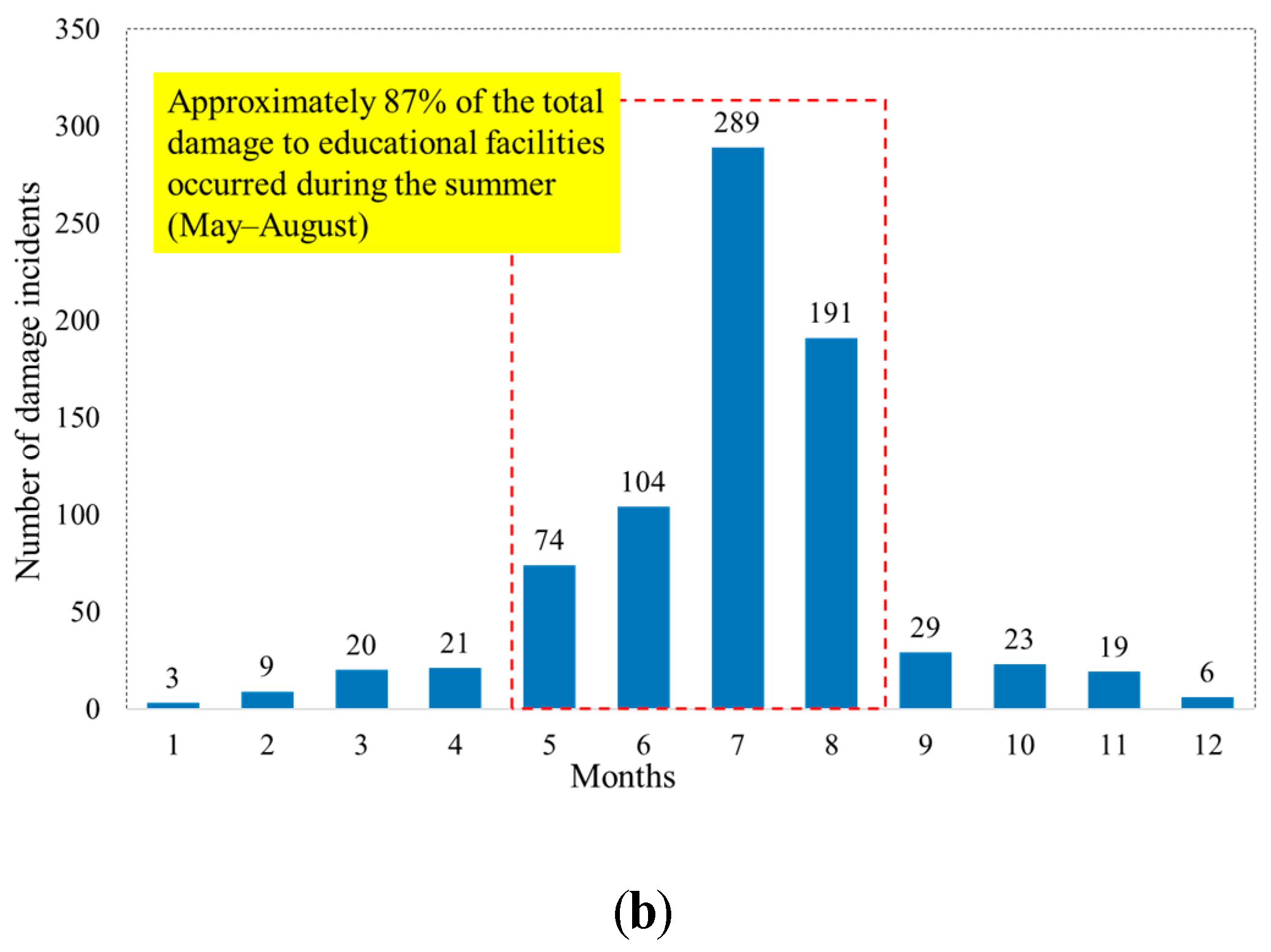

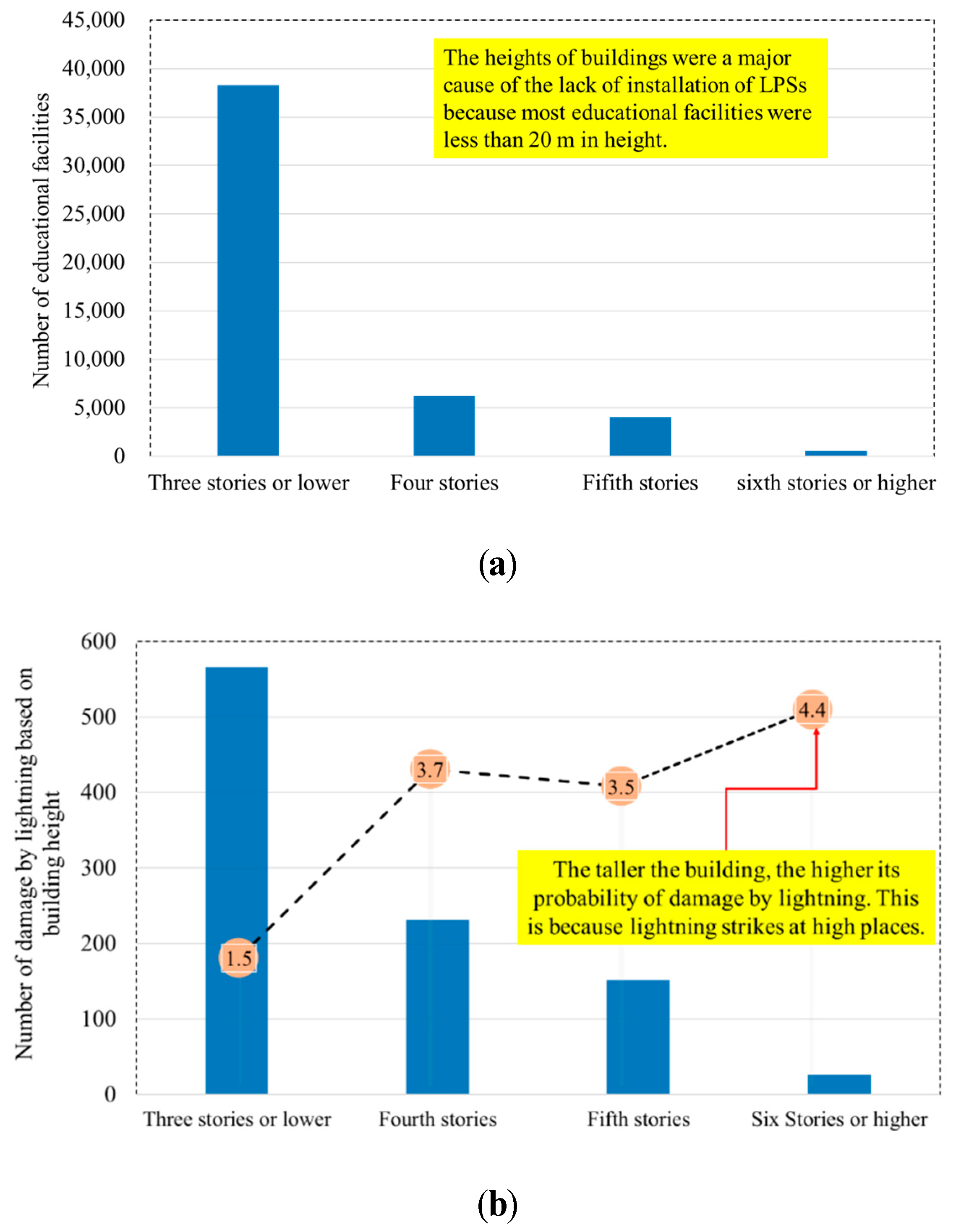
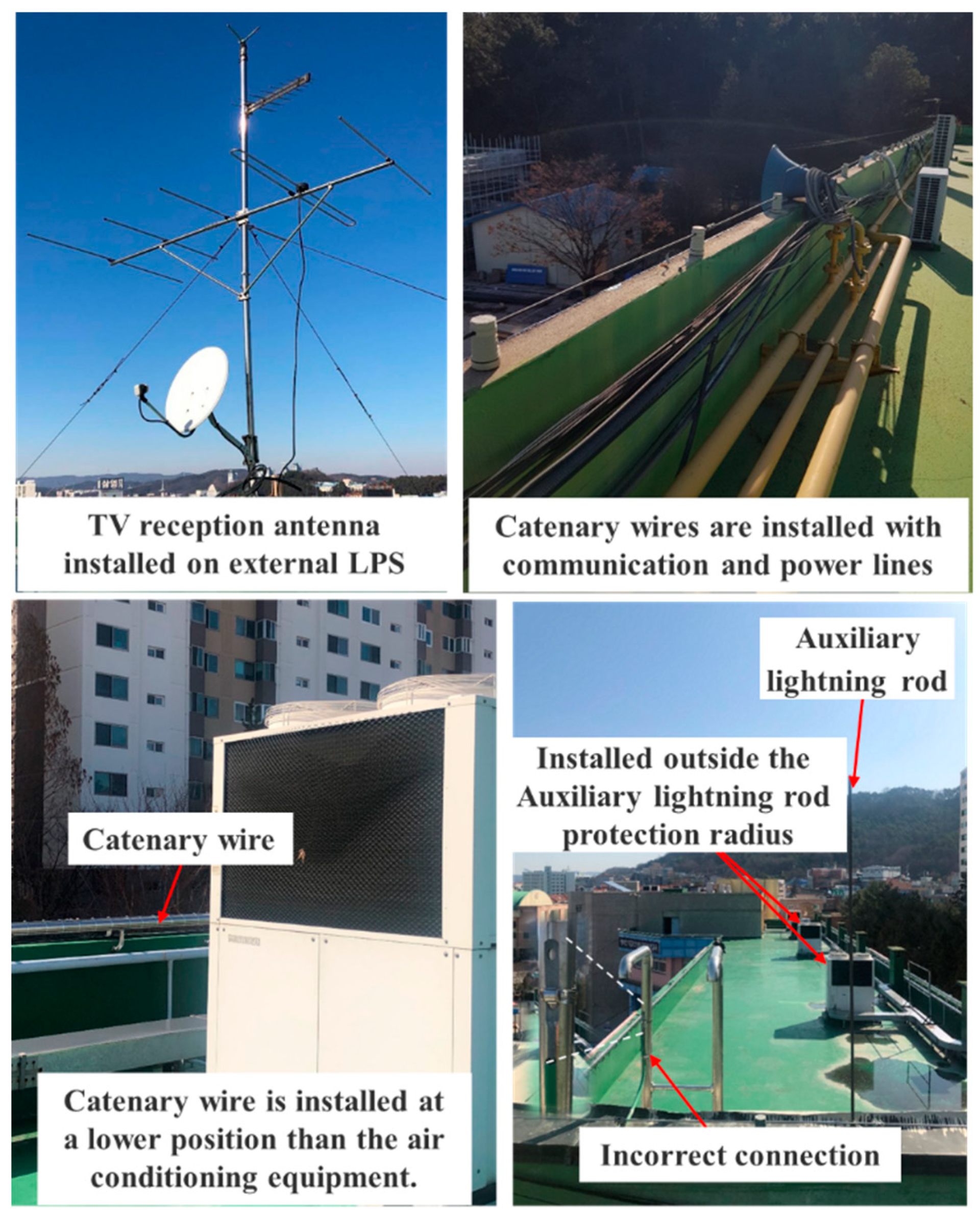

| LPL | I | II | III | IV |
|---|---|---|---|---|
| Maximum current(kA) | 200 | 150 | 100 | 100 |
| Minimum current(kA) | 3 | 5 | 10 | 16 |
| No. | Variable identifier | Parameters |
|---|---|---|
| 1 | School | Elementary, middle, high, special education, etc. |
| 2 | Number of damage incidents | Once, twice, more than three times |
| 3 | When the damage occurred | January to December |
| 4 | Building height | Three stories or less, four stories, fifth stories, sixth stories or higher |
| 5 | Installation of LPSs(external) | Installed, not installed |
| 6 | Air-termination type | Rods, catenary wire, etc. |
| 7 | Installation of LPSs (SPD) | Installed, not installed |
| 8 | Equipotential bonding | Installed, not installed |
| 9 | Damaged system | Cooling and heating system, firefighting system, broadcasting system, elevators, solar power system, CCTVs, other systems |
| 10 | Earthing resistance of LPSs | Less than 10 ohm, less than 30 ohm, less than 50 ohm, less than 100 ohm, more than 100 ohm |
Publisher’s Note: MDPI stays neutral with regard to jurisdictional claims in published maps and institutional affiliations. |
© 2021 by the authors. Licensee MDPI, Basel, Switzerland. This article is an open access article distributed under the terms and conditions of the Creative Commons Attribution (CC BY) license (https://creativecommons.org/licenses/by/4.0/).
Share and Cite
Kang, S.-D.; Kim, S.-C.; Park, K.-B.; Kim, J.-H. A Study on the Current Status and Reduction Method Caused by Lightning at Educational Facilities. Energies 2021, 14, 3015. https://doi.org/10.3390/en14113015
Kang S-D, Kim S-C, Park K-B, Kim J-H. A Study on the Current Status and Reduction Method Caused by Lightning at Educational Facilities. Energies. 2021; 14(11):3015. https://doi.org/10.3390/en14113015
Chicago/Turabian StyleKang, Sin-Dong, Sung-Chul Kim, Ku-Byeoung Park, and Jae-Ho Kim. 2021. "A Study on the Current Status and Reduction Method Caused by Lightning at Educational Facilities" Energies 14, no. 11: 3015. https://doi.org/10.3390/en14113015
APA StyleKang, S.-D., Kim, S.-C., Park, K.-B., & Kim, J.-H. (2021). A Study on the Current Status and Reduction Method Caused by Lightning at Educational Facilities. Energies, 14(11), 3015. https://doi.org/10.3390/en14113015







